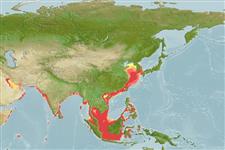Neophocaena phocaenoides (Cuvier, 1829)
Finless porpoise| Native range | All suitable habitat | Point map | Year 2050 |

|
| This map was computer-generated and has not yet been reviewed. |
| Neophocaena phocaenoides AquaMaps Data sources: GBIF OBIS |
Classification / Names Common names | Synonyms | CoL | ITIS | WoRMS
Mammalia | Cetartiodactyla | Phocoenidae
Environment: milieu / climate zone / depth range / distribution range Ecology
Pelagic; anadromous (Ref. 75906); depth range 0 - 250 m (Ref. 356). Tropical; 90°N - 7°S, 46°E - 130°E
Distribution Countries | FAO areas | Ecosystems | Occurrences | Introductions
Indo-West Pacific and Asia Inland Waters: Neophocaena phocaenoides phocaenoides: Persian Gulf, South China Sea, East China Sea, Indonesia, Philippines, Turtle Islands, Sulu Sea; Neophocaena phocaenoides sunameri: China, Korea, Japan, East China Sea; Neophocaena phocaenoides asiaeorientalis: Yangtze River, China (Ref. 1522). Found in tropical to warm temperate coastal waters (Ref. 81021).
Length at first maturity / Size / Weight / Age
Maturity: Lm 140.0, range 135 - 145 cm Max length : 227 cm TL male/unsexed; (Ref. 81030)
Life cycle and mating behavior Maturity | Reproduction | Spawning | Eggs | Fecundity | Larvae
Main reference
References | Coordinator | Collaborators
Tan, J.M.L. 1995 A Field Guide to the Whales and Dolphins in the Philippines. Makati City: Bookmark. 125 p. (Ref. 936)
IUCN Red List Status
(Ref. 130435: Version 2025-1)
CITES status (Ref. 108899)
CMS (Ref. 116361)
Threat to humans
Human uses
Fisheries: commercial
FAO - Fisheries: landings, species profile | FishSource | Sea Around Us
Tools
More information
Max. ages / sizes
Length-weight rel.
Length-length rel.
Length-frequencies
Mass conversion
Abundance
Internet sources
BHL | BOLD Systems | CISTI | DiscoverLife | FAO(Fisheries: species profile; publication : search) | Fishipedia | GenBank (genome, nucleotide) | GloBI | Gomexsi | Google Books | Google Scholar | Google | PubMed | Tree of Life | Wikipedia (Go, Search) | Zoological Record



